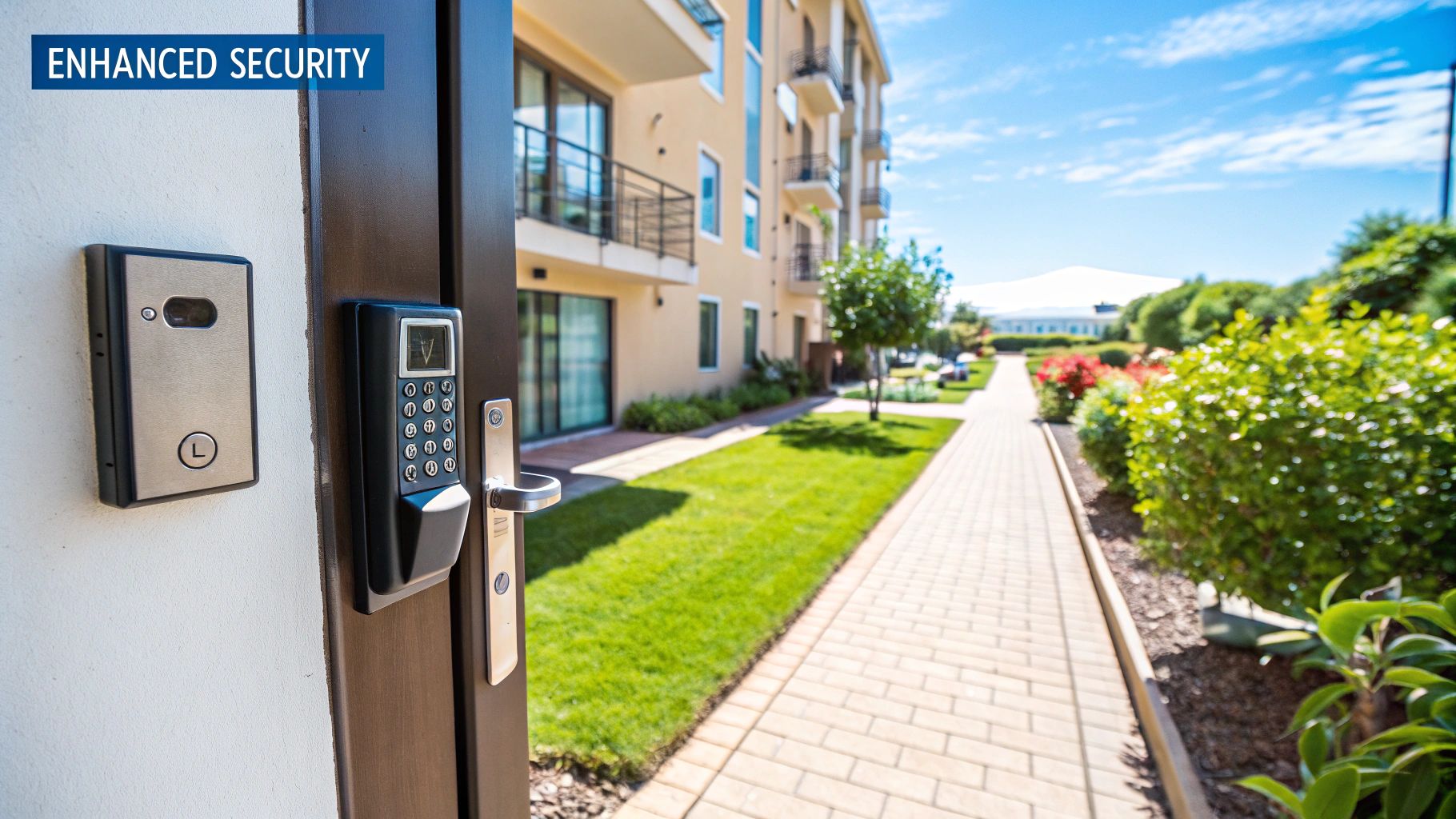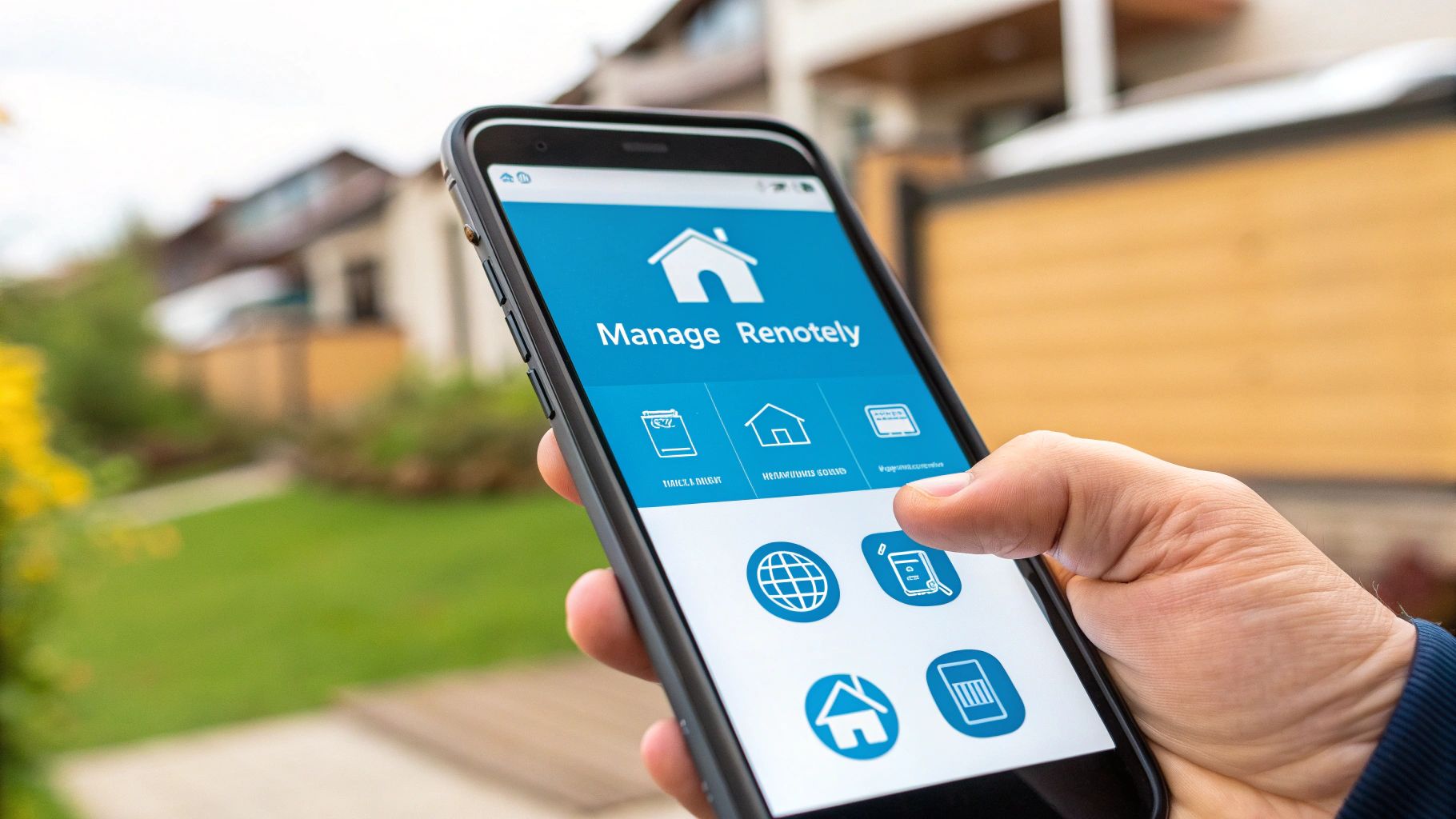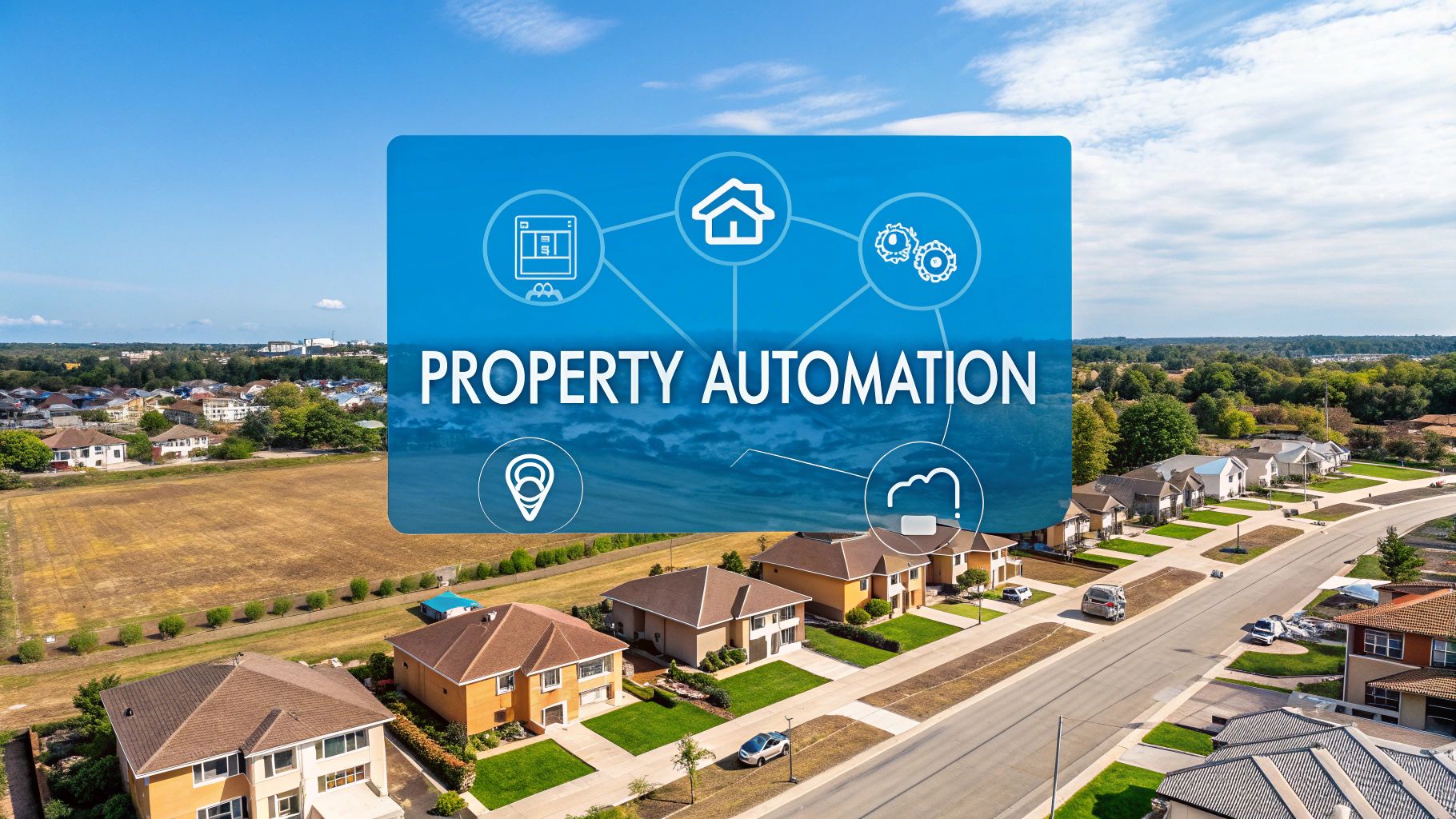For property managers juggling hundreds—or even thousands—of doors, manual leasing isn't just inefficient. It’s a direct drain on portfolio revenue. The tipping point for large-scale operators comes when legacy methods—like manual lead follow-up and the endless back-and-forth of tour scheduling—actively drive up Days on Market (DOM). At that scale, every operational delay directly erodes the bottom line and stifles growth.
This guide provides a framework for automating property management leasing operations, designed specifically for tech-forward companies managing 100 to 10,000+ units. We'll break down the true cost of manual processes, provide a scalable implementation plan, and calculate the direct revenue impact of reducing your DOM.
The True Cost of Manual Leasing Operations at Scale

In today’s competitive rental market, automating your leasing process is non-negotiable infrastructure for enterprise property management. The entire industry is shifting; projections show the global property management market will hit USD 88.37 billion by 2032, fueled almost entirely by automation and AI. This growth puts immense pressure on large-scale operators to meet modern renter expectations while slashing operational overhead on a per-door basis.
For portfolios managing hundreds or thousands of scattered-site units, the cost of operational drag is severe. Every qualified lead left waiting hours for a reply is a potential lease lost to a faster competitor.
Where Traditional Leasing Methods Fail at Scale
Manual processes create hidden costs that multiply across a distributed portfolio. The real problem isn't just wasted administrative time; it's the direct negative impact on your key performance indicators (KPIs) that matter most to stakeholders.
- Delayed Lead Response & Poor Conversion: High-intent renters expect immediate answers. A manual system cannot keep pace with the lead volume from a large portfolio, causing lead-to-tour conversion rates to plummet as prospects move on.
- Scheduling Bottlenecks & Increased DOM: Coordinating tours across dozens of properties, multiple markets, and a limited in-house team is a logistical nightmare. This friction directly adds days to your vacancy period, costing thousands in lost revenue each week.
- Inconsistent Renter Experience: Without a standardized, automated workflow, the leasing experience becomes a lottery depending on which agent a prospect interacts with. This inconsistency damages brand reputation and introduces compliance risks across a multi-market portfolio.
- No Actionable Data for Optimization: Managing leasing in spreadsheets or siloed systems is like flying blind. It's impossible to get a clear, real-time view of your leasing funnel, meaning you can't identify and fix expensive leaks in your process.
To illustrate the stark difference, let's compare the performance of a 1,000+ unit portfolio running on manual processes versus one powered by an integrated automation platform.
Manual vs. Automated Leasing Operations at Scale
The takeaway is clear: automation doesn't just accelerate tasks; it fundamentally improves the financial outcomes of your leasing operations, enabling data-driven decisions and significant cost-per-door savings.
The core issue is that manual leasing treats every unit as an isolated task. An automated system, however, treats your entire portfolio as an integrated revenue engine, optimizing every step from initial inquiry to signed lease for maximum speed and efficiency.
This operational drag doesn't just slow you down; it actively prevents your business from scaling effectively. Exploring the future of property management reveals that leading firms aren’t just adopting new tools—they're completely re-architecting their operations around automation to build a decisive competitive advantage.
A Scalable Framework for Leasing Automation
Implementing property management automation at an enterprise scale requires a strategic, phased blueprint. For portfolios distributed across multiple markets, you can't just flip a switch. It’s about strategically layering in the right technology to build a centralized leasing operation that runs with precision.
The objective is to manage a portfolio across five states with the same efficiency and control as a single building. This is achievable by centralizing lead management, automating tour scheduling, and ensuring seamless integration between your leasing tools and your core Property Management Software (PMS).
Phase 1: Centralize and Qualify Leads Instantly
First, you must capture and qualify every lead the second it arrives. In today's market, speed-to-lead is everything; waiting even a few hours means losing a high-quality prospect to a competitor. Manual follow-up is a critical bottleneck, especially when juggling hundreds of daily inquiries across different time zones.
AI-powered leasing assistants are a game-changer for this phase. These tools integrate with your listings on Zillow, Apartments.com, and your company website, engaging prospects 24/7. They answer common questions, pre-qualify leads based on your specific criteria (income, credit score, move-in date), and nurture them until they're ready for a tour.
By automating the initial response, you plug the single biggest leak in your leasing funnel. You’re not just faster; you deliver a consistent, professional, and immediate experience to every lead, maximizing your lead-to-tour conversion rate.
This shift moves your team from frantically chasing every inquiry to strategically managing a pipeline of highly qualified renters. Instead of drowning in low-intent messages, your leasing agents can focus their energy on high-value prospects who have already been vetted.
Phase 2: Implement Automated, On-Demand Tour Scheduling
Once a lead is qualified, the next hurdle is scheduling the tour. The manual back-and-forth is a massive time-sink and a point of friction that directly increases Days on Market. This challenge is magnified for remote operations without onsite staff.
Automated tour scheduling eliminates this bottleneck entirely. Prospects see real-time availability and can book a showing instantly—whether it's an in-person tour with an on-demand agent or a self-guided tour. This self-service model meets modern renter expectations and dramatically accelerates the leasing timeline. A hot lead that inquires at 10 PM can have a tour confirmed for the next morning without any manual intervention from your team.
This is what a modern, automated leasing operation looks like in practice.

From initial lead capture all the way through to maintenance, interconnected systems create a seamless workflow that eradicates manual busywork.
To execute this across multiple markets, you need a platform that manages a flexible network of showing agents. Tools like Showdigs provide access to a vetted, on-demand network, turning same-day showings from an operational challenge into a scalable reality. You can learn more about how to select and implement these new tools for leasing automation to fit your portfolio's unique needs.
Phase 3: Integrate Systems for a Single Source of Truth
The final and most critical piece is integration. Your new automation tools cannot operate in a vacuum; they must communicate flawlessly with your core PMS, whether it’s AppFolio, Yardi, or another enterprise system. This is achieved through an Application Programming Interface (API).
When your systems are properly integrated, data flows between them automatically. This eliminates manual data entry and creates a single, reliable source of truth for your entire operation.
- Lead to PMS: A new lead qualified by your AI assistant should instantly create a guest card in your PMS.
- Tour to PMS: Once a tour is completed, the prospect’s record is updated with the status and agent feedback.
- Application to PMS: An application link is automatically sent post-tour, and the submitted application flows directly into your screening workflow.
This level of integration is what enables true scalability. It ensures your leasing data is always current, your performance reports are accurate, and your team has a complete view of the funnel from a single dashboard. To make it work, follow proven marketing automation best practices to create a smooth, data-driven renter journey. Without this final step, you’re just building more efficient silos, not an integrated leasing machine.
Calculating the ROI of Your Automation Strategy

Implementing an automation strategy is a direct investment in your portfolio's financial performance. For any results-focused property manager, the decision to adopt new technology hinges on one question: what is the return on investment?
This is where automation transitions from a buzzword to a tangible asset on your balance sheet. The clearest way to measure its impact is by analyzing the metrics you live and breathe: Days on Market (DOM) and cost-per-door efficiency. When you calculate the true cost of vacancy and see how automation shrinks it, the business case becomes undeniable.
Quantifying the Cost of a Vacant Day
Every day a unit sits empty isn't just a missed opportunity; it’s revenue lost forever. To grasp the full financial impact, every portfolio manager must know their daily vacancy cost. The formula is simple but powerful.
Vacancy Cost Formula:(Total Annual Rent Roll / 365 Days) / Total Number of Units = Average Daily Rent Per Unit
Let's apply this to a 2,000-unit portfolio with an average monthly rent of $1,800.
- Annual Rent Roll: 2,000 units x $1,800/month x 12 months = $43,200,000
- Daily Portfolio Rent: $43,200,000 / 365 days = $118,356
- Average Daily Rent Per Unit: $1,800 / 30 days = $60
This means every day a single unit is vacant costs the portfolio $60 in lost revenue. While that may seem small, it compounds at scale. A unit sitting vacant for just one extra week costs $420. If 50 units across your portfolio have their vacancy extended by that same week, you've lost $21,000.
How Automation Slashes Vacancy Costs
This is precisely where automation directly impacts your bottom line. By accelerating every stage of the leasing funnel—from instant lead response to enabling same-day showings—automation directly reduces your average DOM.
Consider that 2,000-unit portfolio. A typical manual leasing process might result in an average DOM of 30 days. By implementing a robust automation system, it is realistic to reduce that by 10 days.
- Days Saved: 10 days
- Revenue Recovered Per Unit: 10 days x $60/day = $600
Now, assuming a standard 30% annual turnover rate (600 units), the portfolio-wide impact becomes massive.
- Total Annual Revenue Recovered: 600 units x $600/unit = $360,000
A 10-day reduction in DOM for a 2,000-unit portfolio can add over a quarter of a million dollars back to your annual revenue. This isn't just an efficiency gain; it's a powerful revenue recovery strategy.
Suddenly, the ROI on effective leasing automation software becomes a clear-cut financial decision. The technology cost is often a fraction of the revenue it recovers.
To illustrate this across different portfolio sizes, the following model shows how a modest 7-day reduction in DOM translates into significant annual revenue gains.
DOM Reduction Revenue Impact Calculator
As demonstrated, the financial upside of trimming your vacancy cycle is undeniable, making DOM reduction a primary focus for portfolio optimization.
Analyzing Cost-Per-Door Efficiency
Beyond filling units faster, automation fundamentally restructures your operational costs. Managing an in-house leasing team across a distributed portfolio carries significant fixed costs: salaries, benefits, mileage, and the administrative overhead of coordination. This model is notoriously difficult to scale efficiently.
Automated showing platforms, particularly those with an on-demand agent network, convert this fixed overhead into a predictable, variable expense tied directly to leasing activity. You only pay for the service when you need it.
This shift dramatically improves your cost-per-door efficiency, a critical metric for any large-scale operator. Instead of hiring more W-2 leasing agents to expand into a new market, you can leverage technology to extend your footprint with minimal increase in fixed costs. This operational leverage is key to profitable growth and is a major component of automation ROI.
When you combine reduced vacancy costs with more efficient operational spending, the financial case for property management automation is overwhelming.
Winning the Race from Lead to Tour

In a competitive rental market, the window of opportunity with a high-intent lead is razor-thin—often just the first five minutes after their initial inquiry. This is the "golden window" when a prospect's interest is at its absolute peak. For large portfolios, manually capitalizing on this window is a logistical impossibility that leads directly to lost leases and higher Days on Market (DOM).
Automation exists to win this critical race at scale. When a prospect reaches out, they expect an immediate, useful response. An automated system delivers exactly that, ensuring every lead receives an instant, personalized reply that captures their interest before competitors can even open their inboxes.
Architecting Your Automated Lead-to-Tour Workflow
An optimized workflow does more than just schedule a showing; it seamlessly guides the prospect through each step, removing friction and building momentum toward a signed lease. This is your opportunity to build a system that not only schedules tours but also pre-qualifies applicants, sends reminders, and gathers feedback for continuous process improvement.
A best-in-class automated sequence includes these key touchpoints:
- Instant Engagement: An AI-powered assistant fields the inquiry in seconds, answers common questions, and provides a link to pre-qualify and book a tour.
- Smart Scheduling: The system displays real-time tour availability, allowing the prospect to book a convenient time slot on the spot.
- Automated Reminders: Once a tour is booked, automated SMS and email reminders are sent to the prospect, significantly reducing no-show rates.
- Post-Tour Follow-Up: Immediately after the showing, the system automatically sends a follow-up requesting feedback and providing a direct link to the application, capitalizing on peak interest.
This isn't a futuristic concept; it's a current industry standard. Recent NMHC data shows that 67% of property management firms already utilize specialized software, and 48% leverage automated lease processing. These tools can compress the entire tenant onboarding timeline from several days to just 48 hours, giving proactive firms a massive competitive advantage.
Making Same-Day Showings a Scalable Reality
For large, distributed portfolios, same-day showings have always been the goal—highly effective but nearly impossible to manage manually. Coordinating with in-house agents across different markets creates insurmountable bottlenecks. A hybrid approach, blending smart software with on-demand services, changes the game.
Platforms like Showdigs integrate scheduling automation with a network of vetted, on-demand showing agents. A qualified lead comes in, and the system can instantly find and dispatch a local agent for a tour that same day. Your leasing operation transforms from a reactive scheduling desk into a proactive, on-demand machine. The benefits of using an AI leasing assistant are magnified when backed by real-world, on-the-ground action.
This model allows enterprise property managers to offer the speed and agility of a local operator with the power and consistency of a large-scale system. It’s how you secure the most motivated renters before they consider other options.
Audit Your Funnel to Eliminate Friction
To optimize your lead-to-tour process, you must identify and eliminate friction. A quick audit can illuminate the bottlenecks costing you leases.
Actionable Checklist for Your Lead-to-Tour Audit:
- Measure Your Initial Response Time: What is the average time between an inquiry and your first reply? If it’s over 15 minutes, you are losing qualified leads.
- Count the Clicks to Schedule: From a listing to a confirmed tour, how many steps must a prospect take? Aim for three clicks or fewer.
- Analyze Your No-Show Rate: What percentage of booked tours are no-shows? A high rate signals a poor scheduling experience or a lack of automated reminders.
- Review Post-Tour Follow-Up: Is there an automated process to send an application link and request feedback immediately after a showing?
- Assess Your After-Hours Strategy: How are leads from nights and weekends handled? Are they being captured and engaged instantly, or are they going cold?
By systematically addressing these friction points with automation, you can significantly improve conversion rates, slash your DOM, and win the race for the best tenants.
Building Your Enterprise PropTech Stack
Your automation strategy is only as good as the technology that powers it. For property management companies managing thousands of units, selecting the right tools is a core business decision that dictates scalability. A fragmented collection of systems creates data silos and operational friction. A well-designed PropTech stack, however, becomes the engine for profitable growth.
The central question for any enterprise portfolio is whether to adopt an all-in-one platform or build a more flexible, best-in-class stack. While all-in-one solutions promise simplicity, they often lack the specialized capabilities needed to optimize critical functions like leasing and showing operations. An API-first approach provides a significant competitive advantage.
All-in-One vs. Best-in-Class Platforms
An API-first strategy involves selecting specialized tools that excel at one function—like lead nurturing or tour scheduling—and connecting them seamlessly to your core Property Management System (PMS). This approach provides the agility to adapt your tech stack as your portfolio grows and new technologies emerge.
The goal is to build a tech ecosystem where data flows freely, creating a single source of truth without sacrificing the power of specialized, best-in-class tools. This prevents vendor lock-in and ensures you are always using the best solution for each part of your operation.
For large, multi-market portfolios, this strategy is almost always superior. You can integrate a top-tier showing management platform directly into your existing PMS, whether it’s Yardi, RealPage, or another system, to create a powerful, customized workflow that no single platform can match.
Core Evaluation Criteria for Enterprise Tools
When vetting new technology for property management automation, your evaluation criteria must be rigorous. A tool must perform as reliably for a 10,000-unit portfolio as it does for a 1,000-unit one.
Use this checklist to evaluate potential platforms:
- Seamless PMS Integration: Does it offer deep, two-way API integrations with enterprise systems like Yardi, RealPage, and AppFolio? Manual data entry between systems is a deal-breaker at scale.
- Proven Scalability: Demand case studies or performance data from portfolios of your size or larger. The system must handle high volumes of leads, tours, and data without performance degradation.
- Granular Data and Reporting: Can you track the metrics that drive revenue? The platform must provide detailed, real-time analytics on KPIs like lead-to-tour conversion rates, showing agent performance, and, most importantly, Days on Market (DOM).
- Support for Remote Operations: Is the tool designed for a distributed portfolio without onsite staff? It should simplify remote management, not create new logistical challenges.
There’s a reason AI-driven tools are gaining traction. Industry benchmarks from the NMHC show that AI adoption among property managers surged from 21% to 34% in just one year, with adopters reporting significantly more optimism about future performance. These firms aren't just buying software; they're investing in scalable infrastructure.
Comparing Operational Models
The technology you choose directly shapes your operational model. A stack built around an on-demand showing service, for instance, fundamentally alters your cost structure and agility compared to relying solely on in-house agents.
For most large, multi-market portfolios, the on-demand model offers superior scalability and cost-per-door efficiency. It allows you to expand your footprint without proportionally increasing headcount—a direct path to profitable growth.
Building the right PropTech stack is about making strategic choices that eliminate operational silos and fuel long-term growth. By prioritizing integration, scalability, and data-driven insights, you can create a technology foundation that delivers a lasting competitive advantage.
Your Top Automation Questions, Answered
Transitioning to an automated leasing system is a significant operational upgrade, and it's natural for leadership to have questions. When we consult with operations directors and portfolio managers, a few key concerns consistently arise. Let's address them directly.
"How long does implementation take for a large portfolio?"
For a portfolio with over 1,000 units, this is an engine upgrade, not just a software install. A strategic, phased rollout is essential, with a full implementation typically taking 60 to 90 days.
Here’s a standard timeline:
- Weeks 1-2: System Integration. The technical teams connect the automation software to your core PMS—like AppFolio or Yardi—via its API. This ensures seamless, two-way data flow from day one.
- Weeks 3-4: The Pilot Program. We start with a select group of properties in one market to test and refine the new workflows in a controlled environment. This allows us to gather performance data and resolve any issues before a full-scale launch.
- Weeks 5-12: Full Rollout & Training. Following a successful pilot, we expand the system across the entire portfolio. This phase focuses on comprehensive team training and establishing performance monitoring to ensure adoption and success.
"How do we get our leasing agents to adopt the new system?"
Agent buy-in is non-negotiable, and it begins by demonstrating how the technology makes their jobs easier and more lucrative. The goal is not to replace them but to empower them.
Position the platform as a powerful assistant that handles the repetitive, low-value tasks they dislike—like manual lead follow-up and scheduling coordination. When you show them how the system delivers a steady stream of pre-qualified, tour-ready renters directly to their calendars, they will see the value. They can finally stop digging through an overflowing inbox and focus on what they do best: building rapport, conducting great tours, and closing leases.
Key Takeaway: Automation doesn't replace high-performing leasing agents; it supercharges them. It eliminates administrative friction so they can handle more tours, convert more leads, and ultimately, earn more commissions.
"Won't automation feel impersonal to renters?"
This is a common concern, but the reality is the opposite. Modern automation creates a superior renter experience by delivering the speed, convenience, and reliability that consumers now expect in every aspect of their lives.
In an on-demand world, waiting hours for a response to a rental inquiry feels outdated and frustrating. An automated system provides what renters want: instant, 24/7 answers and the ability to self-schedule a tour at their convenience, even at 10 PM on a Saturday. This self-service approach delivers a consistent, professional, and highly responsive experience from the first click, ensuring no lead ever falls through the cracks—which is far more personal than being ignored in a crowded inbox.
Ready to see how a purpose-built automation platform can slash your DOM and boost your portfolio's revenue? Showdigs combines AI-powered software with an on-demand agent network to create the fastest path from lead to lease for distributed portfolios.







